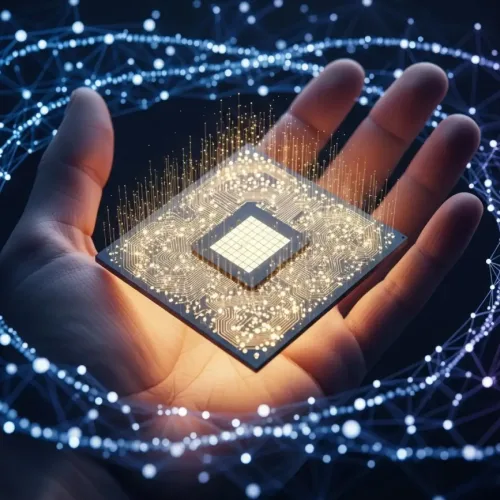On a hot summer day, when you are doing any work, sweat starts dripping from your body, and in the same way, when you sit on a chilly winter day, you shiver. Our body works like a thermostat, turning on the air conditioner when it gets too hot and turning on the heater when it gets too cold. This balance is maintained all the time without we are having to think about it. Our heart beats faster when we climb stairs. Breathing deepens during exercise. Blood sugar stays stable between meals. This process relies on negative feedback loops. Sensors detect changes and trigger responses to counteract them. This ensures that our body temperature hovers around 98.6°F and blood sugar remains stable. This is how the human body works.
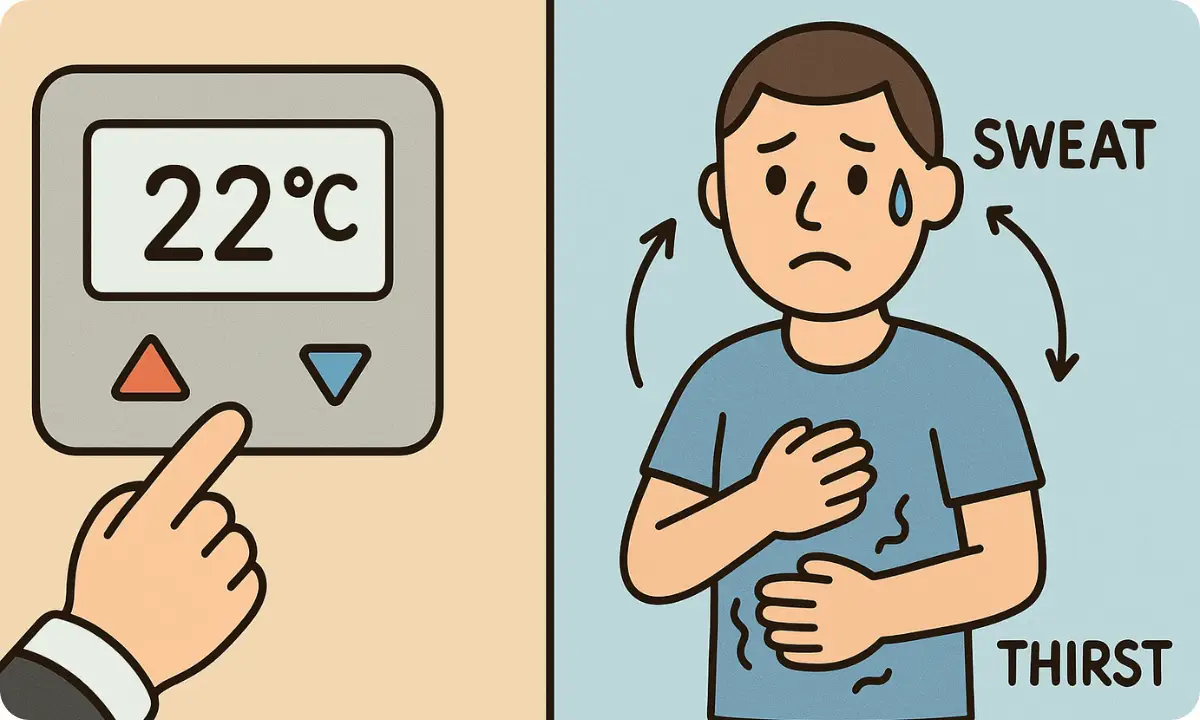
It is very important to understand that there are 11 systems inside our body that works together like a team. All these systems carry out their respective functions well without interfering with each other’s work, but rather help each other. When you read this entire article, the picture will become very clear in front of you.
From Small to Big: Cells → Tissues → Organs → Systems
Before we move on to the 11 systems, let’s quickly understand how they are built. And our body works step by step like a ladder:
cells → tissues → organs → systems
Now, let’s dive into these building blocks.
1. Cells
Cells are the basic building blocks of our body. Each cell performs its own job. Like heart cells help in our heart beat. Brain cells send instant messages. Skin cells protect our skin for different challenges. Cells also carry out all essential processes of life, such as energy production, growth, reproduction, and responding to the environment.
2. Tissues
When similar types of cells merge, tissues are formed. For example, heart tissue is made up of many heart cells that help our heart beat continuously. Nervous tissue in our brain helps us in thinking and remembering different tasks.
3. Organs
Organs are formed when tissues work together to achieve larger tasks. Our heart is made up of muscle, connective, and nervous tissue to pump blood. Our lungs use different tissues to help us breathe.
4. Systems
Systems are groups of organs that work together to carry out important body functions. Our cardiovascular system includes our heart, blood vessels, and blood, all of which help in delivering oxygen and nutrients to where they are needed.
This simple theory helps explain several phenomena. It explains why a paper cut heals, as cells grow back. It also clarifies why our heart races when we exercise, due to tissue responding as needed. Additionally, it shows why we can think while walking, because systems work smoothly. If you want to learn more about cells, The Body: A Guide for Occupants by Bill Bryson gives interesting information about how our tiny cells work together to do many important things.
Meet Our 11 Body Systems and Learn How the Human Body works
1. Circulatory system
Our circulatory system works like a delivery service. It brings important things like oxygen and nutrients to our bodies and removes wastes like carbon dioxide. The heart is a vital pump that moves blood through more than 60,000 miles of blood vessels. When we climb stairs and our heart beats faster, it’s because our body needs more oxygen for our muscles.
Blood vessels are very efficient. The smallest ones, called capillaries, are narrow. Red blood cells can move through them one by one. This helps to efficiently exchange oxygen and nutrients. There are about 10 billion of these tiny pathways in our body.
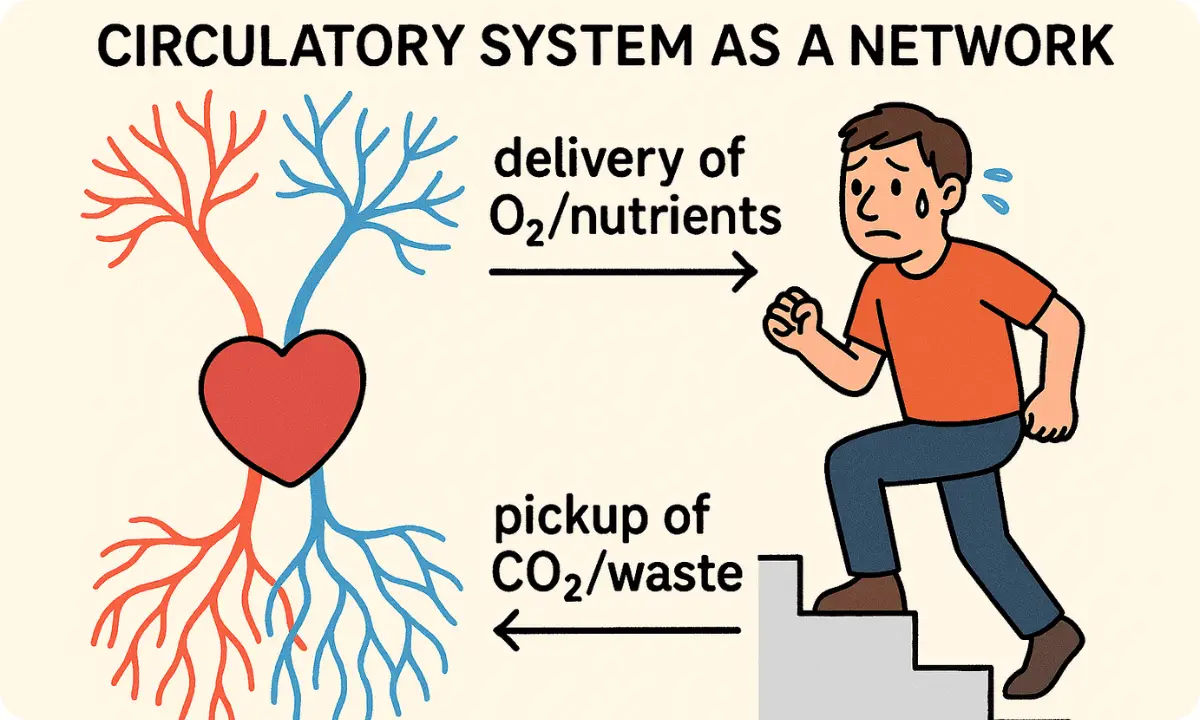
Homeostasis support: Our cardiovascular system maintains blood pressure, distributes heat, and transports hormones that regulate other systems.
Care tip: Regular movement strengthens our heart muscle and improves circulation. Even a 10-minute walk gets our delivery network humming.
2. Respiratory System
Every breath we take is a two-way trade: we take in oxygen and breathe out carbon dioxide. Our respiratory system handles this gas exchange through a complex network of tubes from our nose to tiny air sacs called alveoli in our lungs. You may have noticed that when air passes through our nose, it is warmed, moistened, and filtered. It continues down our trachea, branches through the bronchi, and ends in about 300 million alveoli. These are microscopic air sacs where a kind of magic happens — oxygen enters our bloodstream while carbon dioxide is expelled.
Oxygen-rich blood leaves our lungs and heads straight to our heart, which pumps it throughout our body. Meanwhile, blood filled with carbon dioxide returns to our lungs for respiratory exchange.
Homeostasis support: Breathing regulates blood pH levels and removes metabolic waste gases, keeping our internal chemistry in balance.
Care tip: Deep breathing exercises strengthen respiratory muscles and improve oxygen efficiency. Try the 4-7-8 technique: inhale for 4 counts, hold for 7, exhale for 8.
3. Digestive System
If I were to tell you about the digestive system in simple words, it would work like a fuel factory inside our body. When we eat any food, our digestive system breaks down the food into complex molecules and divides them into small molecules that are used as nutrients by different parts of our body. To understand this concept, you can visit our detailed article From Mouth to Brain.
The journey begins in our mouths with enzymes in saliva that act like tiny molecular scissors, cutting starch into smaller pieces. Our stomach adds powerful acids and more enzymes. Our small intestine — despite being “small,” it’s actually about 20 feet long — does most of the heavy lifting, with help from our liver and pancreas.
I would like to give you an example here to explain the concept: The sandwich you ate is broken down into glucose for quick energy, amino acids to make protein, and fatty acids for long-term energy storage. Nutrients pass through your intestinal wall and enter your bloodstream, where your circulatory system delivers them to wherever they’re needed.
Homeostasis support: Our digestive system maintains blood sugar levels and provides the raw materials every other system needs to function.
Care tip: Eating a variety of whole foods gives our digestive enzymes different nutrients to work with, supporting optimal breakdown and absorption.
4. Skeletal System
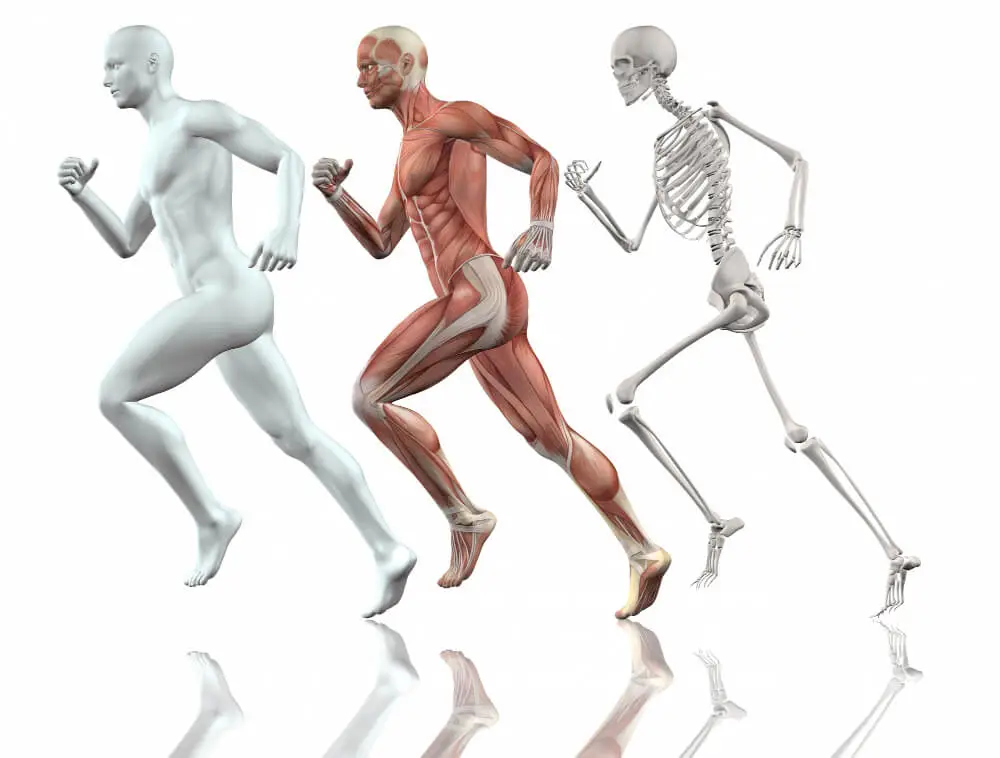
Our 206 bones do more than hold us upright. Think of your skeletal system as a three-in-one marvel: a structural framework, protective armor, and blood cell factory.
As your framework, bones provide attachment points for muscles and maintain your shape. As armor, your skull protects your brain, your rib cage protects your heart and lungs, and your spine protects your spinal cord.
But here’s a hidden superpower: Your bones are living tissue that constantly rebuilds itself. Inside your bones, spongy marrow produces millions of new blood cells every day. Red blood cells carry oxygen, white blood cells fight infection, and platelets help clot.
Homeostasis support: Bones store and release calcium and phosphorus to maintain proper mineral balance in our blood.
Care tip: Weight-bearing exercises like walking, dancing, or resistance training stimulate bone-building cells called osteoblasts, keeping our skeletal system strong.
5. Muscular System
Our muscular system includes more than 600 muscles that produce movement, maintain posture, and generate heat. We have three types of muscles: skeletal muscles that you consciously control, smooth muscles in our limbs that work automatically, and cardiac muscles in our heart.
Skeletal muscles work in pairs — when our biceps contract to bend our arm, our triceps relax. When we want to straighten our arm, they switch roles. This coordinated opposition creates precise, controlled movement.
Our muscles are also heat generators. Ever wondered how you get warm during exercise? They convert chemical energy (ATP from cellular respiration) into mechanical energy, with heat as a natural byproduct. Shivering When we’re cold, our muscles contract to generate heat that quickly warms us up.
Homeostasis support: Muscle contractions help to circulate blood and lymph fluid, support temperature regulation, and maintain posture against gravity.
Care tip: Regular stretching and strength training maintain muscle flexibility and power. Our muscles adapt quickly—even a few weeks of consistent activity shows improvement.
6. Nervous System
Our nervous system is the ultimate communication network, sending lightning-fast messages throughout our bodies. It consists of the brain, spinal cord, and a vast network of nerves.
When we touch a hot stove, it’s a perfect example of a reflex arc in action. Specialized nerve cells called neurons immediately send signals from our hand to our spinal cord, which immediately sends signals back to our muscles to pull your hand away. All of this happens before our brains can fully register the pain. The nervous system works alongside the endocrine system to coordinate our body’s response to the world around us.
Supports Homeostasis: Coordinates all bodily functions and responds to internal and external changes to maintain stability.
Care Tip: Focus on sleep that allow your brain function to collect memories and repair itself.
7. Endocrine System
If the nervous system is the body’s fast messenger, the endocrine system is its slow mail. It uses chemical messengers called hormones to send signals through our bloodstream. Despite being slow, its effects are often long-lasting and widespread.
Everyday examples of hormones in action include the adrenaline rush you feel during a stressful moment, the growth spurts you experience as a teenager, or the sleepiness that signals that it’s time to go to bed (due to melatonin).
Homeostasis support: Hormones fine-tune nearly every body task, from blood sugar and blood pressure to mood and energy levels.
Care tip: Consistent sleep schedules support healthy hormone cycles. Many important hormones follow circadian rhythms tied to light-dark patterns.
8. Immune/Lymphatic System
Our immune system is like a combination security team and cleaning crew. It identifies and neutralizes threats (bacteria, viruses, damaged cells) while our lymphatic system provides drainage and transport.
White blood cells patrol our bloodstream and tissues like protective guards. When they meet invaders, they sound the alarm, call for backup, and launch targeted attacks. Some white blood cells “remember” earlier threats, which is why vaccines work—they train our immune system to recognize and respond to specific threats.
Our lymphatic system runs parallel to our bloodstream but carries clear lymph fluid instead of red blood. It collects excess fluid from tissues, filters it through lymph nodes (those little lumps we feel when we’re sick), and returns the clean fluid to our bloodstream.
Homeostasis support: These systems maintain internal cleanliness by removing cellular waste, fighting infections, and regulating fluid balance.
Care tip: Regular movement helps pump lymph fluid since the lymphatic system lacks a central pump like the heart. Light bouncing, walking, or yoga supports lymph circulation. To understand how gut health affects the immune system, read The Microbiome Solution by Robynne Chutkan. It explains the important link between digestion and immunity.
9. Integumentary System
Our skin doesn’t just cover us – it’s our largest organ and a delicate interface between our inner and outer worlds. The integumentary system includes our skin, hair and nails.
As a barrier, skin keeps harmful substances out while preventing water loss. Acting as a temperature controller, skin regulates blood flow and stimulates sweat glands to maintain our internal temperature. When exposed to sunlight, skin also produces vitamin D, supporting bone health and immune function.
Our skin is constantly renewing itself, shedding around 30,000 dead cells every day. These cells are replaced by new cells growing from deeper layers, which continually create a fresh protective layer.
Supports Homeostasis: Regulates body temperature, protects against pathogens, and synthesizes vitamin D.
Care Tip: Protect your skin from the sun and keep it hydrated to maintain its barrier function.
10. Urinary system
Our urinary system works like a sophisticated water treatment plant that filters out waste while preserving what our bodies need. Our two kidneys process about 50 gallons of blood each day, removing waste while retaining useful substances.
The basic functional unit is the nephron — each kidney has about a million of these microscopic filtering units. Blood enters under pressure, water, and small molecules are filtered, and our kidneys then decide what to reabsorb and what to excrete based on our body’s current needs.
When we are dehydrated, our kidneys conserve water by concentrating our urine. When we drink too much fluid, they excrete excess water to prevent a dangerous dilution of our blood chemistry.
Homeostasis support: Kidneys regulate blood pressure, maintain electrolyte balance, control blood pH, and remove metabolic waste products.
Care tip: Consistent hydration supports kidney function. Your urine color is a good indicator—pale yellow suggests good hydration, while dark yellow indicates you need more fluids.
11. Reproductive System
Our reproductive system fulfills the biological need for species continuation while also influencing many other body functions through hormone production.
In addition to reproduction, reproductive hormones affect bone density, muscle mass, mood, and cardiovascular health. Estrogen supports bone strength and heart health. Testosterone influences muscle growth and red blood cell production.
Understanding reproductive health is crucial to overall health. These hormones interact with almost every other system, affecting everything from metabolism to immune function.
Homeostasis support: Reproductive hormones help maintain bone density, influence mood regulation, and support overall metabolic health.
Care tip: Regular healthcare checkups support reproductive health, which benefits overall wellness through hormone balance and early detection of potential issues.
I hope your concept about the 11 most important systems of our body has become quite clear. Now let’s go deeper into this concept and learn about the working of these systems and the problems they face.
Systems Don’t Work Alone: Everyday Scenarios
To truly understand how the human body works, you have to see these systems in action. Here are a few short stories that show how they work together.
1. From Snack to Energy in 60 Seconds

Let’s find out what happens when you eat an apple. Your digestive system starts working right away — enzymes in your saliva start breaking down the natural sugars. As you chew and swallow, your stomach adds acid to continue the breakdown process.
Within minutes, glucose from the apple enters your bloodstream through your small intestine. Your circulatory system carries this glucose to cells throughout your body. Your pancreas (endocrine system) releases insulin to help cells absorb the glucose.
Inside your cells, mitochondria — tiny cellular powerhouses — convert glucose into ATP, which is considered the global currency of energy. This process requires oxygen, which works together with your respiratory and circulatory systems. The entire process from bite to cellular energy takes less than an hour.
2. Why Breathing Harder Fuels Muscles
You start jogging.
- Muscular System: Your leg muscles need more energy to move, which means they need more oxygen.
- Respiratory System: Your brain (nervous system) signals to your lungs that more oxygen is needed. You start breathing faster and deeper, pulling in more air.
- Circulatory System: Your heart rate increases, pumping the oxygen-rich blood faster to your working muscles.
- Negative Feedback: As your muscles get the oxygen they need, it self-regulates. Your breathing and heart rate will slow down once the demand for oxygen drops. This is a perfect example of a negative feedback loop in action.
This beautiful coordination happens automatically. Your conscious mind focuses on the exercise while your body systems seamlessly adjust their output to meet demand.
3. Fight or Flight in Action
Imagine being startled by a loud noise, which we hear all the time. Your nervous system immediately processes the potential threat and signals your adrenal glands (endocrine system) to release stress hormones such as adrenaline.
Within seconds, your cardiovascular system responds — your heart rate increases, your blood pressure rises, and blood flow is redirected to your muscles. Your respiratory system quickens, your breathing becomes rapid and shallow. Your muscular system tenses up, ready for action.
Even your digestive system gets the message, temporarily shutting down to conserve energy for an emergency response. This entire cascade happens in a matter of moments, demonstrating the incredible coordination between your nervous, endocrine, and other body systems.
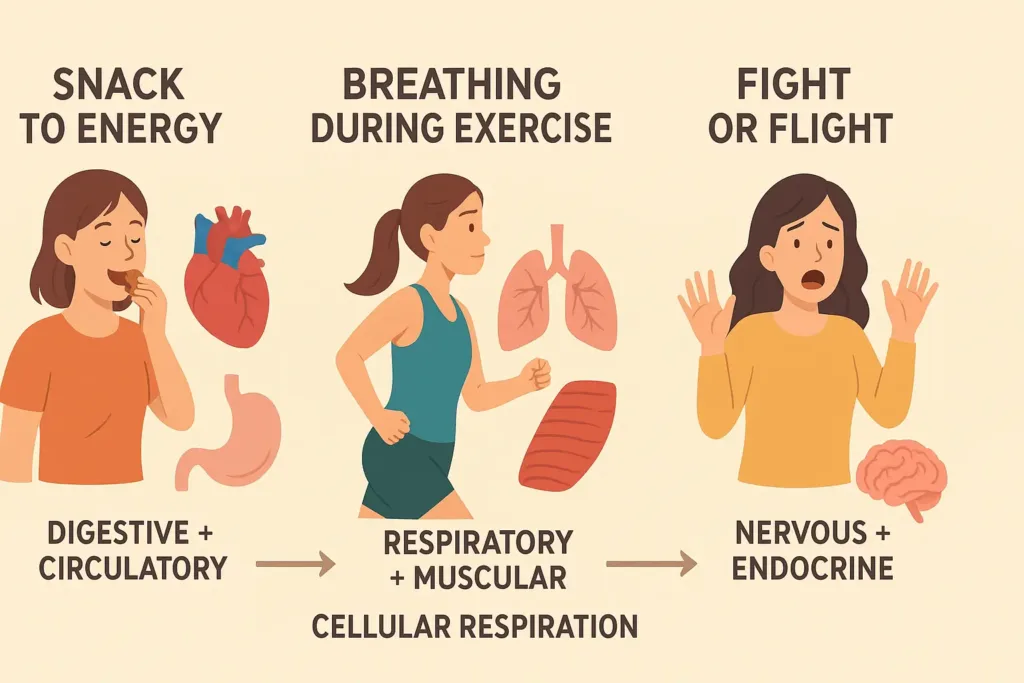
Common Myths, Busted
It’s easy to believe misinformation. Here are some common myths about the body, debunked.
- “You only use 10% of your brain.” No. Brain scans show activity in most areas of the brain, even during simple tasks. Your brain is active all the time, even when you’re sleeping.
- “Sweat = fat leaving your body.” Sorry, but no. Sweat is mainly water and salts, and your body uses it for thermoregulation (cooling). Fat leaves your body primarily through the process of being excreted as carbon dioxide and used for energy.
- “Detox diets clean your organs.” Your body already has two incredible organs for this: your liver and kidneys. They work tirelessly to filter toxins and waste from your body. There is no evidence that “detox” diets do anything helpful.
How to Care for Your Systems
Create habits that support your body’s various systems. Get 7-9 hours of sleep each night to help your nervous and hormonal systems function well. Moving your body for 30 minutes a day improves your blood flow and muscle health, and helps your body remove waste.
Eating a variety of foods like fruits, vegetables, and protein helps your digestive and immune systems function better. Drinking plenty of water keeps your urinary system and skin healthy, preventing dryness. Protect your skin from the sun, and use simple stress relief techniques to help calm your nerves. Remember, staying hydrated helps with everything because water is essential for every cell in your body.
Conclusion
Finally I would say learning how the human body works isn’t just about memorizing complicated charts. It’s about understanding the amazing teamwork going on inside you all the time. Every part, from your fast-paced nervous system to your hard-working kidneys, helps keep your body in balance.
What can you do today? Take a 10-minute walk, drink a glass of water, and go to bed a little earlier. These simple actions can help you take care of your body and its amazing teamwork.
Recommended Reads for Curious Minds
For deeper dives, check these helpful resources:
- The Human Body by Richard Walker
- Anatomy and Physiology For Dummies by Erin Odya
- The Telomere Effect by Elizabeth Blackburn
People Also Ask
Most anatomy books list 11 main body systems, which we’ve talked about here. But some books group them in other ways. For example, some combine the immune and lymphatic systems, while others split the musculoskeletal system into skeletal and muscular parts. It is less important to know the exact number than to understand how these systems work together.
Homeostasis is how your body keeps everything balanced inside. It’s important because it helps you stay healthy. If your body can’t keep this balance, it means something is wrong, which can make you sick.
There is no one “most important” system. The human body shows how all systems depend on each other. The circulatory system needs the respiratory system for oxygen. The nervous system needs the digestive system for energy. Every system is important.
Food can take anywhere from 24 to 72 hours to move through your digestive system. This time can change based on how fast your body works, what kind of food you eat (foods with a lot of fiber digest quicker), and how much water you drink.

